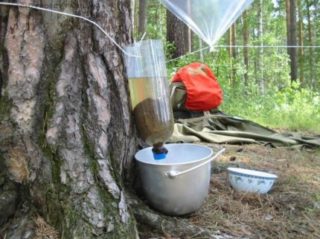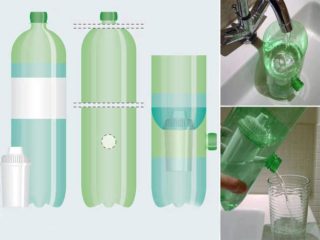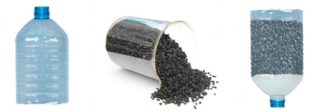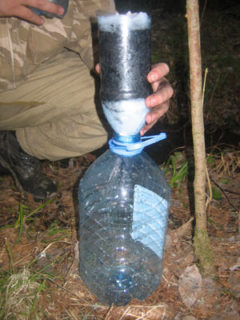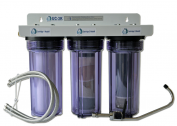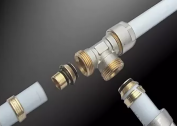Home-made filtering devices for rough water purification is a necessary thing in everyday life, since far from always boiling is enough. You can make them without special knowledge and skills from available materials. Do-it-yourself constructions purify water from large solid impurities and are also able to improve the composition of water. The result depends on the filter medium used.
Necessary tools and materials
The complete list of materials and tools used depends on the type of filter that will be manufactured. Universal materials and work equipment are as follows:
- five-liter plastic bottle (it will serve as a filter housing);
- a piece of natural rag or gauze folded in several layers;
- a reservoir for collecting purified water;
- small shells and pure quartz sand;
- knife;
- charcoal.
Many have difficulties with the extraction of the last material - charcoal. Cooking it is quite simple. It is necessary to fill the crushed wood of deciduous trees without bark in a metal container. It is best to use aspen or birch. Prepared raw materials on fire. As soon as the tree becomes hot and begins to smoke, the reservoir with the contents is left and cooled.
For the preparation of coal, coniferous trees are not used, since they contain essential oils that spoil the taste of water. The most effective is a do-it-yourself carbon filter for water, equipped with several layers.
Coarse water filter at home
To make the simplest design, you will need to prepare a clean plastic bottle with a volume of up to 1.5 liters and a cartridge for one of the finished store products, for example, the Barrier. One cartridge is enough to clean approximately 180 liters of liquid, then it is replaced with a new one.
The manufacturing algorithm is as follows:
- The upper part of the plastic container is accurately marked and cut off, the height should be approximately the same with the height of the cartridge.
- The filter element is inserted into the container through the cut-off neck until it stops. Places where the structure rests are marked with a marker.
- The marked area on the plastic is cut off. The result is a kind of funnel.
- The final stage - a cartridge is placed in the lower part of the bottle of a cylindrical shape together with a funnel.
After contamination, the purchased cartridge must be removed, because otherwise pathogenic microflora can settle in a home-made design.
There is another option for a homemade filter. The role of the cartridge is performed by a two-liter plastic bottle filled with a filter mixture, the body is a bucket with a lid. This method of cleansing is conveniently used during rest or on hikes when the liquid is taken from open water bodies.
The manufacturing technology of the device is as follows:
- There must be a hole on the lid of the bucket. As a rule, you have to do it yourself. The diameter should be equal to the size of the neck of the bottle. The latter is led into it from the outside.
- Before tightening the threads, 6-7 through holes need to be made in the plastic bottle cap. This can be done with a thin drill or a hot awl. In the latter case, the holes are best made from the inside.
- The lower part of the bottle is cut off, after which the edges are slightly melted using a lighter. If you neglect this item, when laying the filter mixture can be injured.
- If the bottle is suspended above the bucket, holes are made on both sides of the rope.
- In traveling conditions, cotton pads or clean cotton are inserted into the neck. If the filter is prepared for use at home, it is better to give preference to lutrasil, folded in several layers.
- Charcoal or crushed activated charcoal is placed on cotton, cotton pads or lutrasil. The thicker this layer, the better the liquid will be cleaned.
- The filter medium is covered with cotton wool on top, and then with a layer of natural rags. In camping conditions, you can use a clean handkerchief as a rag.
- A cropped plastic bag is laid on top of the laid layers, and in the upper part of the bottle is fixed to its edges. This allows you to quickly remove contaminated filter media from the tank.
At the end, check the operability of the device by pouring a small amount of water. As it cleanses, it will drain into a bucket.
The advantage of this design is that it can be used not only at home, but also in hiking conditions.
Features of home-made flow filters
Water purification is especially effective if it is previously subjected to rough cleaning. Mechanical filters are recommended to be installed at the pipeline inlet to a house or apartment. With their help, water is cleaned of rust, sand and other solid particles of large sizes, which shorten the life of plumbing and household appliances, adversely affect well-being and human health.
After rough cleaning, it is recommended to expose the water to a more thorough treatment. At home, the following filler materials are used:
- coal;
- cotton wool;
- grass;
- paper napkins;
- different natural fabrics;
- filter sand.
In addition, the use of silver is considered an effective way to filter water. Metal is famous for its ability to destroy pathogenic and pathogenic microflora. Another time-tested filter is silicon. It has a pronounced disinfecting action, is an effective absorbent.
The benefits of home-made water purification filters:
- you can make a homemade water filter in the country or while on the go;
- requires minimal financial investment;
- with the help of the filter it is possible to get rid of the unpleasant odor and taste of water;
- products effectively separate large solid particles from the liquid.
Among the disadvantages, it is possible to completely get rid of pathogens - water can threaten human health if it is not additionally treated thermally.
